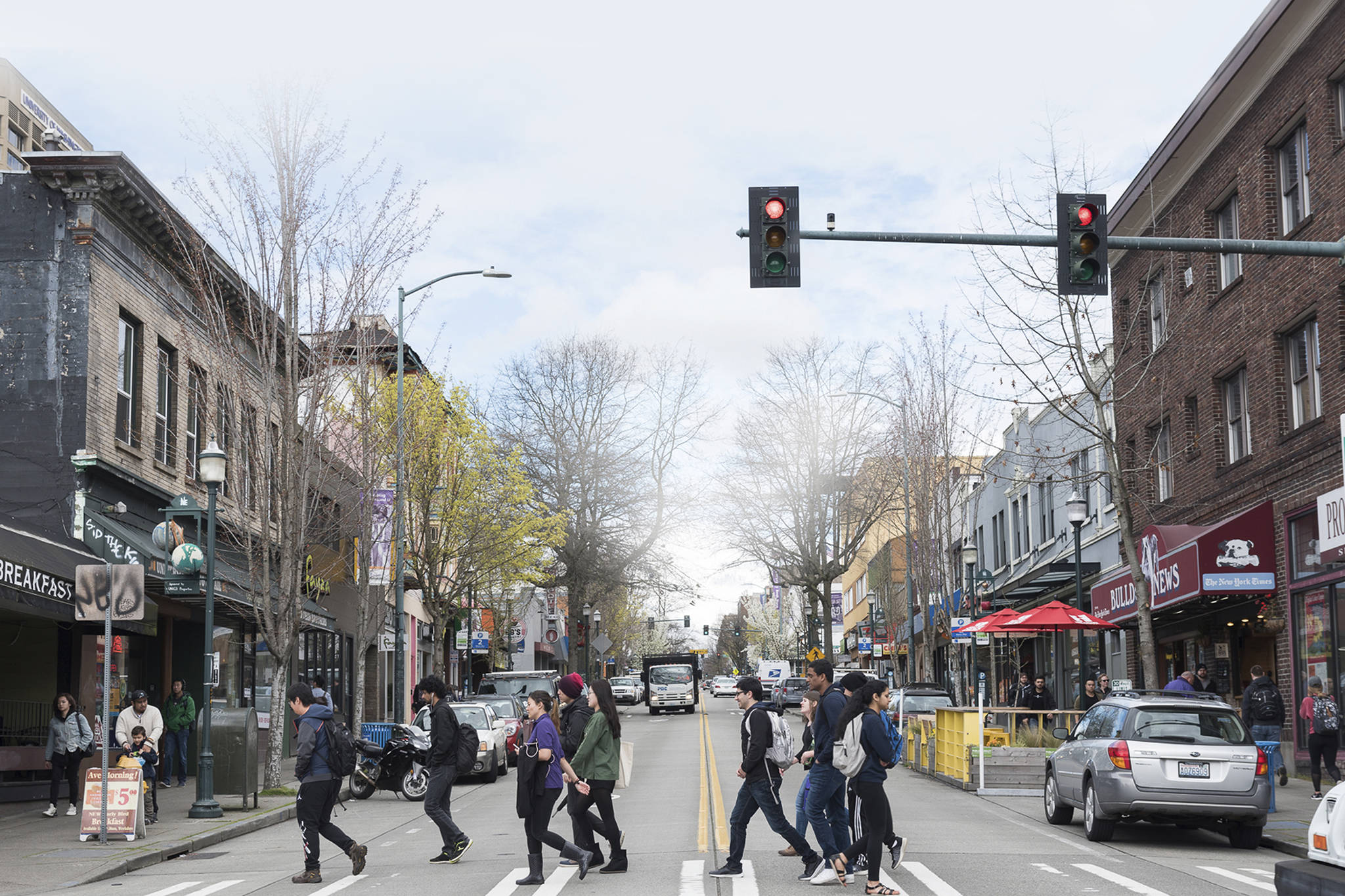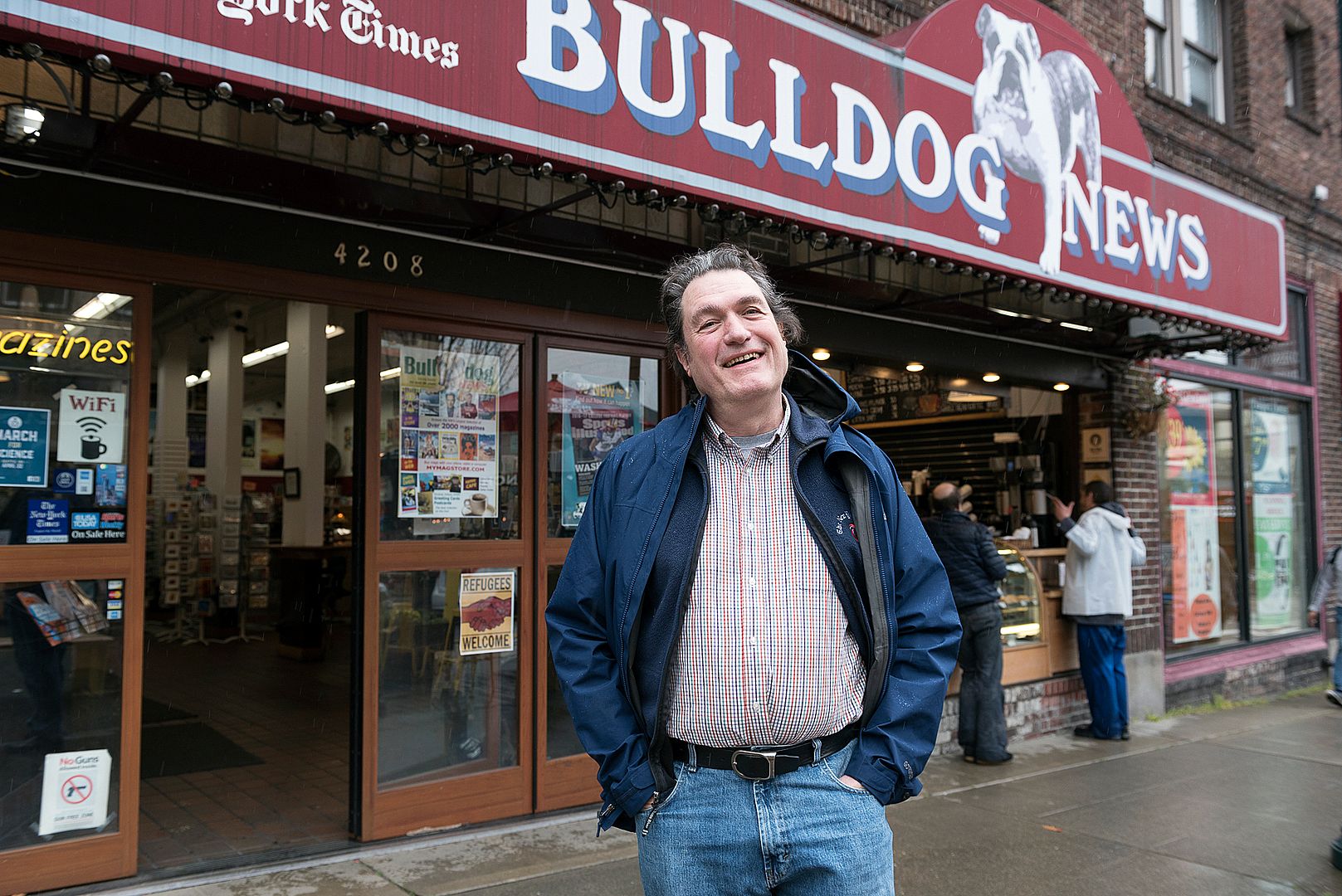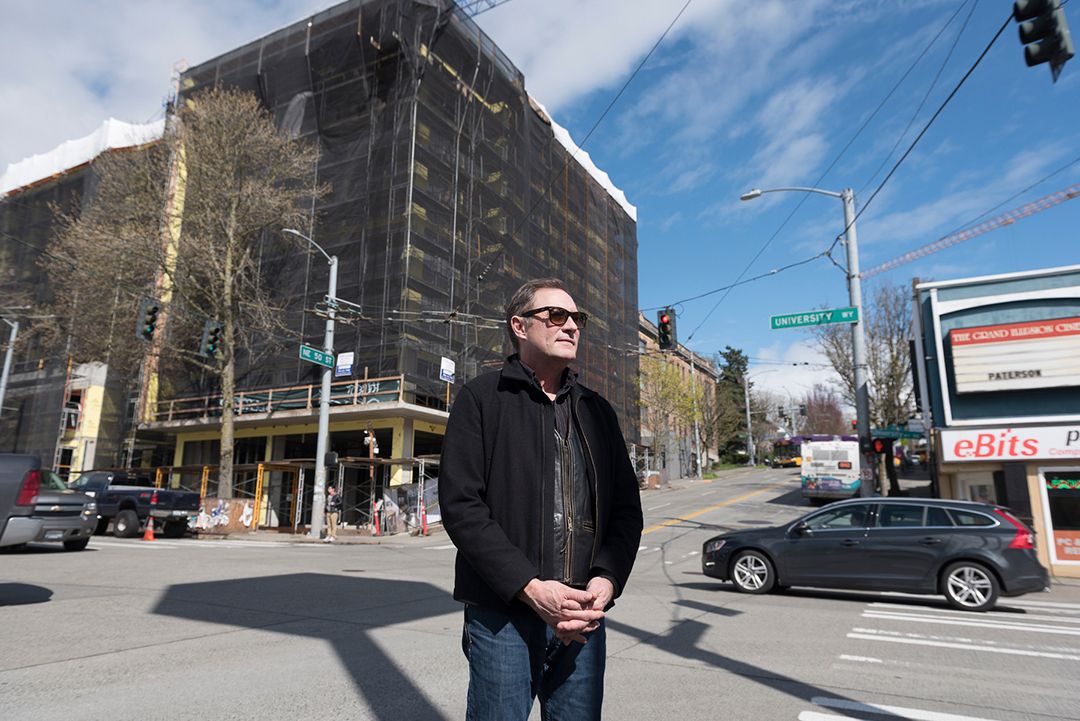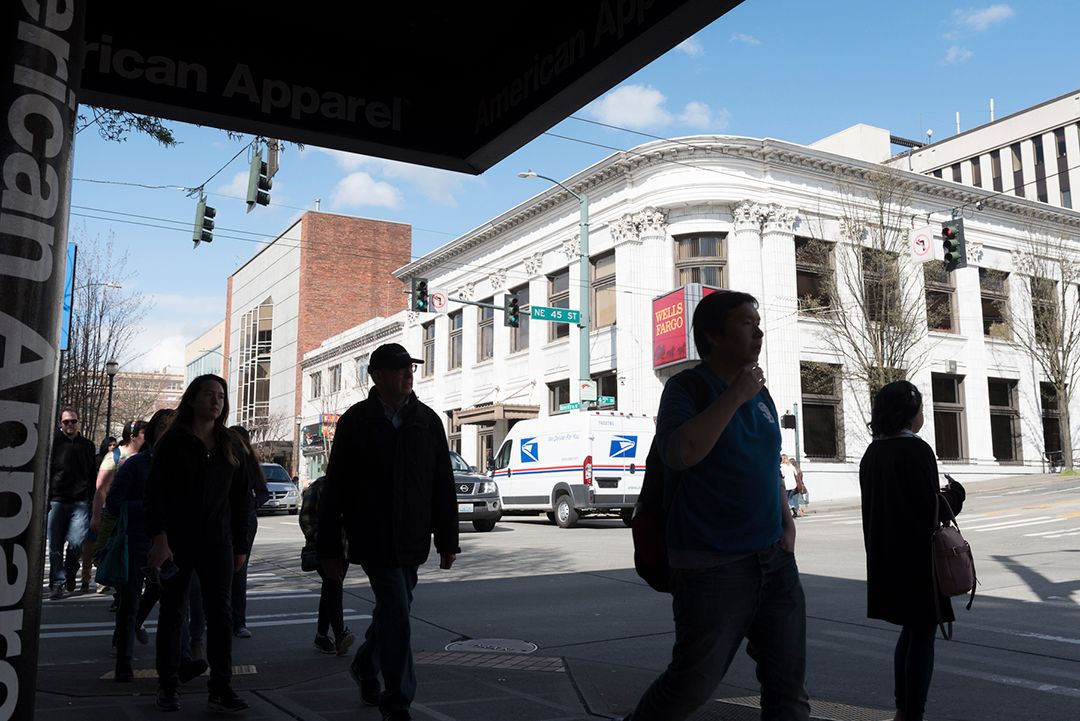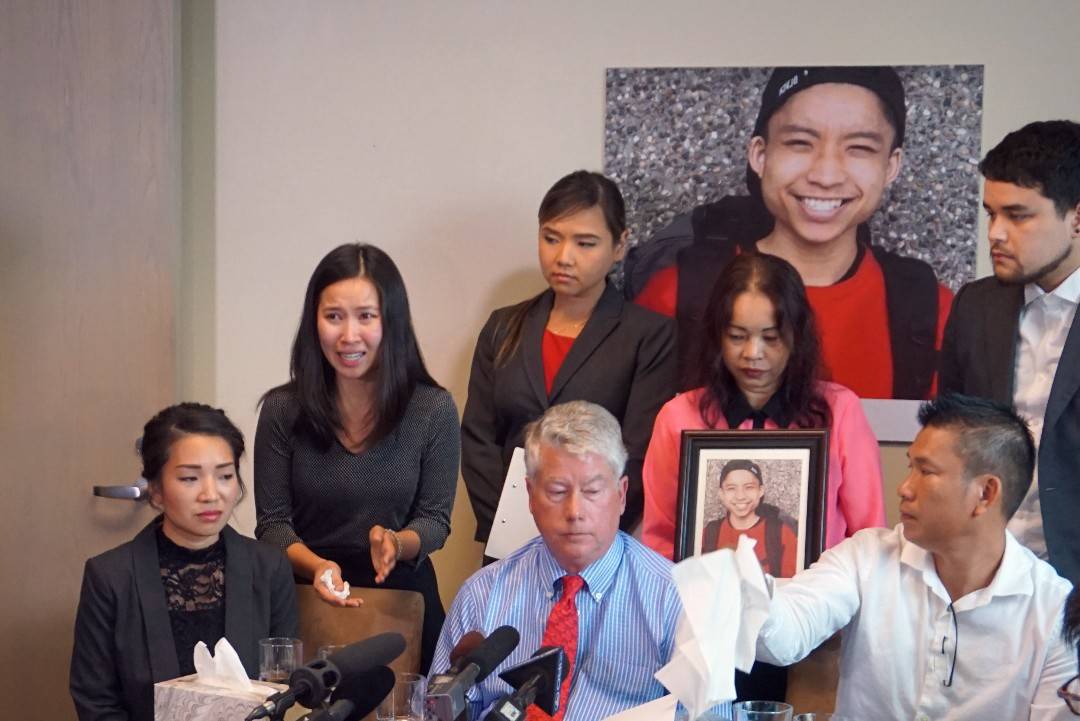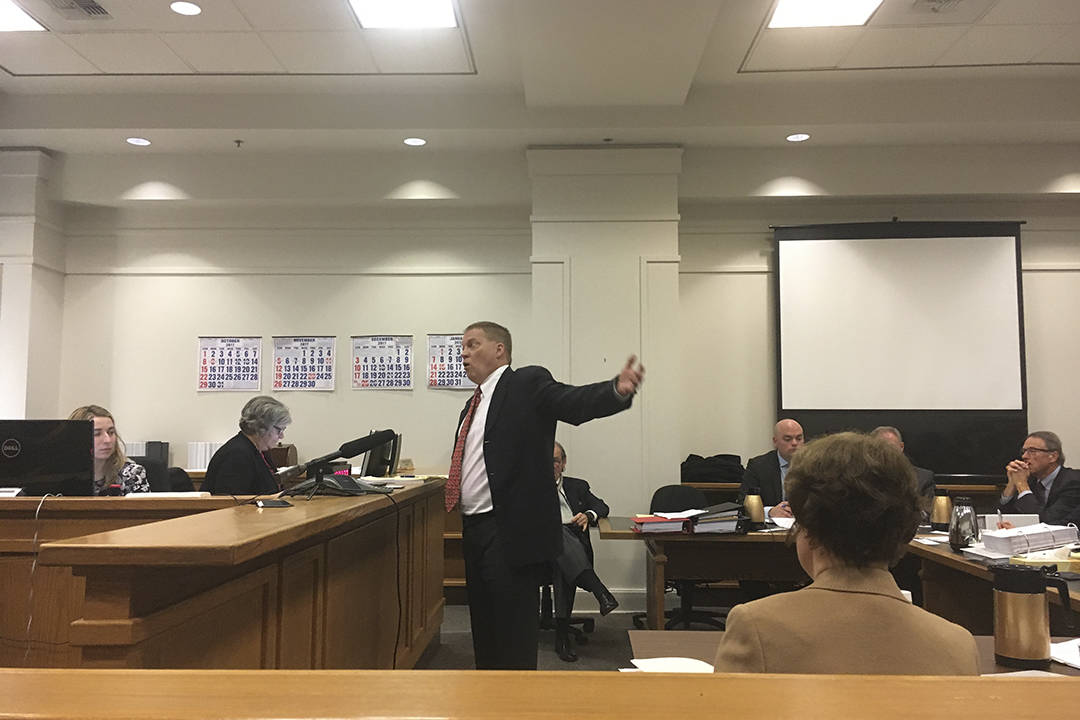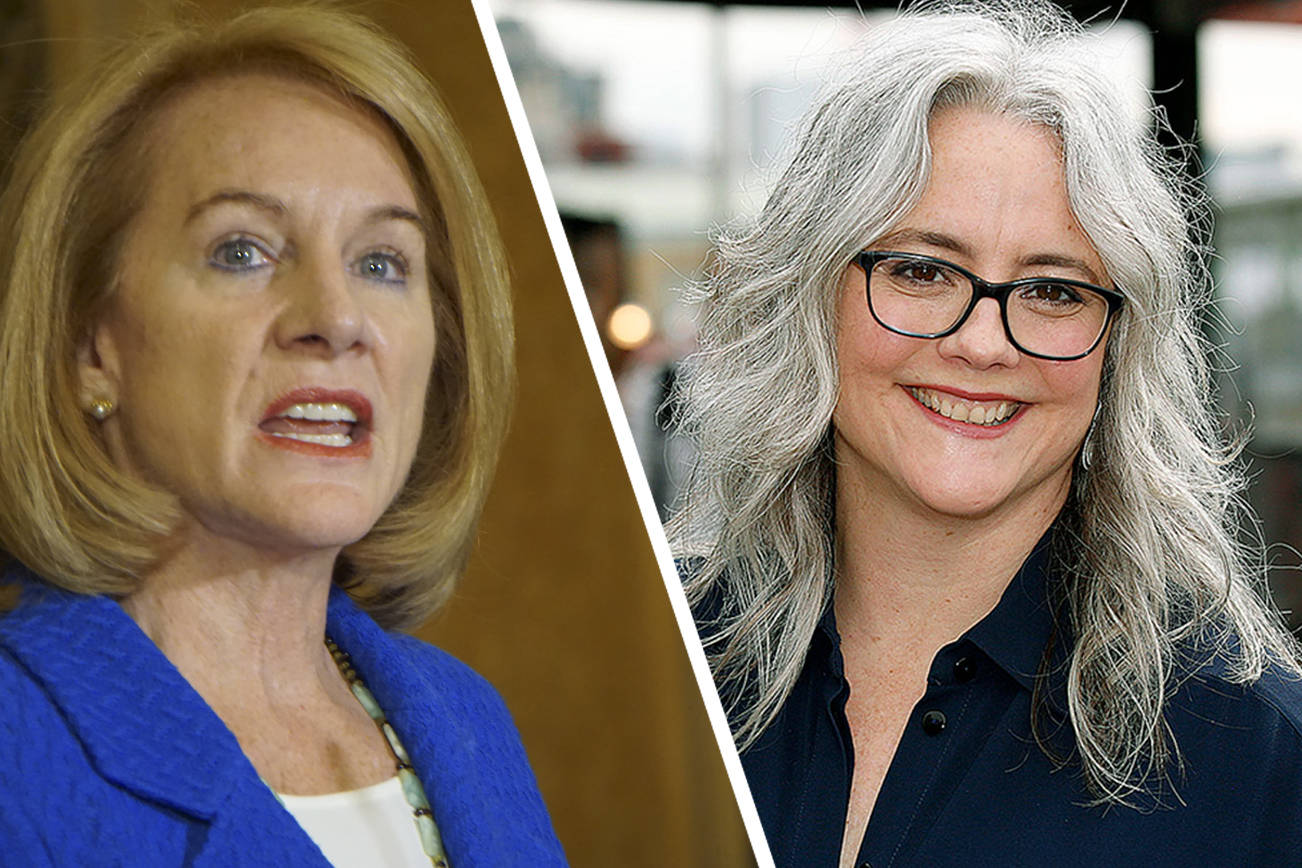The first card is an auspicious one: Justice.
“This card can mean compromise,” René Aceves says. “This will underlie everything else that goes on here.”
He continues to deal from his deck of finger-worn tarot cards. Soon a beastly red devil appears.
“This card shows the more distant past. We usually think of the distant past as more than a year ago. I attended a meeting about a year ago, and back then, if the developers had had their way, it would have been very bad. People who like this neighborhood would have just felt fucked in the ass,” he says. “So to go from the Devil to Justice is a good thing. That’s a very, very good thing.”
If you didn’t guess, Aceves isn’t doing a tarot reading for your average customer. Rather, at the request of Seattle Weekly, he is doing a reading for the Ave, the motley strip of University Way Northeast with a future that is very much in question and the topic of plenty of speculation. In February, after years of studies, community forums, and debate, the Seattle City Council voted unanimously to significantly rezone the U District, the scruffy neighborhood of which the Ave is the commercial center. However, as so often happens in municipal matters, years of downtown planning have run up against a concerted last-minute surge of resistance from those in the neighborhood who fear the changes that will follow those new zoning laws.
As is, the Ave can seem frozen in time. Cheap noodle joints crowd against hookah lounges, dealers of psychic readings against dealers of esoterica. Some shops, like The Gargoyles Statuary, which sells exactly what its name implies, force one to ponder: How is that even a business? Add to this tableau college kids, street kids, drug dealers, and old men with the zonked-out look that comes after eight hours spent contemplating 17th-century philosophy, and you end up with a neighborhood that’s been called everything from “funky” to “gross,” but never “gentrified.” Indeed, the Ave lacks that most ubiquitous of Seattle icons: the proposed land-use sign that denotes the next building developers plan to demolish to make way for a new office tower or high-rise condo.
This state of affairs explains the deep, even existential, anxiety about City Hall’s designs for the place. For those who love the Ave, this brick-and-mortar neighborhood can seem as fragile as a Fabergé egg. The worry is that even a slight change to rules, such as how tall a building on the street can be, will make it the next mark for developers looking for their piece of the Seattle real-estate bonanza. Once that happens, the thought goes, the Ave will follow the well-practiced steps of New Seattle: tenants get pushed out, old buildings get demolished, and in their stead come modern, monolithic mid-rises with chain restaurants on the ground floor.
“It sometimes seems that the vision that the property owners have is that everything south of 50th becomes a fast-food zone,” argues Doug Campbell, owner of Bulldog News, the Ave’s iconic newsstand and coffee shop, and an outspoken advocate for the business district.
Doug Campbell wants to keep the Ave as is.
The City Council vote to rezone the U District in February was a dark cloud with a silver lining for people like Campbell. The Council vote paved the way for much taller buildings to be built in the neighborhood: as high as 320 feet, nearly quadruple the previous 85-foot zoning rule. To people like Campbell, it feels as though the city is trying to make the U District as packed with towers as it can.
By city officials’ own telling, the aim of this rezone is to spur developers to tear down the current stock—old, low-rise buildings—and construct towers with lots more apartments, easing the housing shortage in the city. By neighborhood advocates’ telling, the upzone is the end of the U District as we know it. Yet the vote also provided a reprieve, perhaps a temporary one, for the Ave. While the neighborhood around it got upzoned, the Council decided to hold off on changing the rules governing the corridor along University Way Northeast between Northeast 42nd Street and Northeast 50th Street—the Ave’s generally agreed-upon boundaries. This has provided lovers of the Ave with time to make their case as to why it’s worth saving, but has brought little clarity to what may be in store for the strip.
Aceves, who does tarot and psychic readings in a small cubby in a corner of Gargoyles Statuary, is trying to bring some clairvoyance to the issue. Card after card falls to the table. To a lay person, cards like the Four of Pinnacles—showing a man with four towers behind him—seems to spell out that high-rises are coming; the 10 of Daggers—showing a man with 10 knives in his back—bodes poorly for the prospect of anyone coming out of the debate unwounded. But to Aceves’ trained eye, the future of the Ave is not in developers’ favor.
“This is a very interesting reading,” he says, looking at the mess of cards before him. “Sometimes people lose complete hope because it’s the big shots against the little people … It will get tenser and tenser and the sides will become more evenly matched to the point where local people who own the shops and that sort of stuff, they get more and more power in them, and they get more and more say.
“I think the developers will get something, in the near future, but they’re never satisfied.”
It was a rail line that made the Ave.
In the late 1800s, as the neighborhood was just starting to form, developer James Moore envisioned what is today 15th Avenue Northeast as the area’s main business strip. However, another developer, David Denny, had other ideas. In 1892, he built an electric trolley up the street that would become University Way, which spurred a lively commercial development around it—leaving 15th to play a secondary role in the neighborhood.
While the trolley was eventually removed—going the way, in the mid-20th century, of nearly all the rest of Seattle’s 231 miles of financially troubled street rail—the U District remained a vibrant commercial district with the Ave at its center. Considered a city within a city, for decades the U District was defined less by its bohemian cool than by its modern retail offerings—JC Penney, Nordstrom, and the like. Famed U District resident and historian Walt Crowley summed up the mood of University Way in 1960 as “prosperous and confident.” “The Ave proudly advertised itself as ‘A Department Store Eight Blocks Long,’ and the future looked bright. No one in 1960 anticipated that the Ave would become a battleground in a virtual cultural revolution just a few years hence,” Crowley wrote.
That revolution arrived in the form of a youth counterculture that experimented with drugs, sex, and activism, earning the neighborhood comparisons to San Francisco’s Haight-Ashbury and Berkeley’s Telegraph Alley. “The U District has always had a wide-open, experimental kind of quality to it,” says Campbell. “I moved here in 1969 from Spokane. There were drug dealers, but they were much gentler than they are now. The ’60s and the ’70s were a heyday for the U District in openness and taking on new challenge.”
That said, he added, not all was copacetic. The ’60s saw the rise of a standoff between property owners—many of whom were absentee landlords with little day-to-day interest in the neighborhood—and tenants who felt ownership of the strip. “I think it’s fair to say that the property owners felt under siege at that time,” Campbell says.
While the strife between owners and tenants took many forms, a clear example was the push, in 1971, to close University Way to traffic altogether and turn it into a walking mall. Many of those who spent their lives on the Ave loved the idea. Many of those who owned property there hated it. The idea had actually first been proposed in 1955 by Victor Steinbrueck, the legendary University of Washington architecture professor and preservationist. According to History Link, a U District development council formally proposed the idea in December 1971, with a plan that required significant buy-in (and investment) from property owners. Yet it was a hard sell to those for whom the Ave’s buildings were simply an investment and who “could not be expected to share the concerns of engaged merchants and district residents,” Crowley wrote. An area real-estate agent opposed to the idea rallied the opposition, which stopped the plan dead in its tracks. Crowley writes that with the failed plan, “The last, best chance for the community to shape the Ave’s destiny had come and gone.”
Today, this 120-year sweep of history appears to be folding back against the U District. Just as in 1892, a rail line again is poised to redefine the area—this time in the form of the link light-rail station currently under construction just west of University Way at 43rd and scheduled to open in 2021. The zoning debate has again laid bare the divergent interests of landowners and their tenants, with the tenants again fighting for their right to shape the Ave’s destiny. There’s even a Steinbrueck involved—Victor’s son Peter, who has been commissioned by small-business owners to study how an upzone might affect the Ave’s livability.
Peter Steinbrueck sees value in the Ave’s aesthetic.
It is a rare sunny March morning when I meet Peter Steinbrueck on the corner of 42nd and University. He is taking me on a walking tour of the street his family has had an intellectual interest in for more than half a century. His observations, informed not just by his preservationist lineage but by an extensive academic background in architecture that includes teaching stints at Harvard, can seem a little squishy compared to the hard numbers of population and development projections the city relies on. But he says they are observations that a city overlooks at its own peril. Pointing to a line of buildings that look worse for the wear, he rightly notes that the streetscape has a pleasing aesthetic. And, he argues, that matters when it comes to creating neighborhoods that people want to interact with.
“You’re going to be more inclined to walk around if there is more to see. This ever-changing scenery—it’s satisfying to us… . It’s an endorphin rush,” he says, letting his preservationist flag fly. Later he points out how the low buildings, typically no more than three stories, allow the sidewalk to get bathed in sunlight—when there is any sunlight to be offered. “Daylight! We crave it, we need it. When we get it, we’re happy,” he says.
All this said, at one point I express doubt that all the great things about the U District can boil down to zoning decisions. After all, everything people love about the neighborhood seems to be the product not of city planning, but of a certain lack of it. There’s little consistency in terms of building design, or height for that matter. That is, it feels entirely organic.
“You can’t zone for character, that’s true,” Steinbrueck allows. “But you can zone it away.”
Steinbrueck says the city does have tools to protect places like the Ave. Community development grants, for example, have been used in South Seattle and the Central District to protect businesses from the impact of major infrastructure overhauls. Another possibility he floated is the creation of a historic district: “We want to formulate a plan for retaining businesses, protecting historical legacy businesses, and maybe some new approaches the city could utilize,” he says. He says the city could use the Ave as a model for future business districts that will face similar challenges as the city seeks to increase density across the map. “The issue will rise elsewhere.”
Distilled to its most basic elements, the argument for the U District upzone is this: Seattle’s population is exploding, the city needs housing, and the U District is a perfect place to put it: relatively close to downtown and soon to be connected to the city center by a light-rail line that taxpayers will spend billions on. City planners have estimated that the upzone could result in the building of 5,000 new market-rate apartments. Given the current pace of 1,100 people moving to Seattle each week, there seems to be little doubt they will be filled.
On top of this, the city’s Mandatory Housing Affordability program, created as part of the Housing Affordability and Livability Agenda, stipulates that 9 percent of the new housing units created in new developments be rent-controlled for those making below Seattle’s medium income. Developers can get around this requirement by paying an equal amount into the Seattle housing fund, money that can be used to fund nonprofit affordable-housing projects similar to the 12th Avenue Arts building on Capitol Hill. City planners say Seattle could gain between 600 and 900 affordable-housing units as a result of to the U District upzone.
It adds up to a strong argument. Despite a late push led by affordable-housing advocates who argued that the upzone is a bad deal for low-income renters—since it will cause old apartment buildings with low rent to be torn down—the Council approved the zoning changes by a vote of 9-0.
However, the Council has been decidedly less sure about what it should do with the Ave. As originally crafted, the upzone would have increased the allowed building height along the Ave from 65 to 85 feet. Modest as this seems, it was enough to prompt many business owners to show up at Council chambers, wearing green scarves that became the mark of the Livable U District contingent, to testify against the plan, saying the change in zoning could spur displacement. The Council then lowered the building height to 75 feet, which still spurred protest. Finally, in February, Councilmember Rob Johnson, the chair of the Council’s zoning committee and whose district includes the U District, proposed pausing the upzone on the Ave altogether to allow more time for neighbors to provide input.
Conciliatory as these steps were, they came with a healthy dose of skepticism from Councilmembers as to whether the Ave should be entirely spared from development. Even Councilmember Lisa Herbold, who has pushed for more preservation efforts in the city—including a legacy business program to help save beloved neighborhood institutions—sounded a sharply doubtful note during a hearing on the matter. “I’m not convinced that the small upzone of 10 feet on the Ave is going to have the displacement impacts that people are concerned [with],” she said during a January meeting of the Planning, Land Use and Zoning (PLUZ) Committee. She then added, “But I also recognize that we don’t know what we don’t know.”
In a meeting the folllowing month, Councilmember Sally Bagshaw noted: “We hear some businesses are saying that we can hardly wait to get more people into the area because people that have resources are going to contribute to the well-being of small businesses. But others say, ‘We don’t want change.’ ”
Complicating matters is the MHA program. By state law, the city can force developers to include affordable housing in developments only if it comes in conjunction with an upzone or similar pro-development policy changes. The idea is that upzones are an asset being provided to developers, so the city is within its rights to levy a fee on it. Conversely, without an upzone, enacting MHA would be illegal, since it would amount to taking property without compensation. While MHA fees are being pitched by City Hall as a measure to limit the impact of development in Seattle, it’s also true that the MHA program puts pressure on city officials to create upzones to begin with in order to “capture” the MHA money. It’s something of a catch 22: Don’t provide upzones, and you risk development happening with no benefit to affordable housing; provide upzones, and you encourage the development that many see as a factor in the affordability crisis to begin with.
This dynamic was on display during a December PLUZ committee hearing. To a room scattered with green scarves, Councilmember Mike O’Brien contemplated how the Council could satisfy the neighborhood’s concerns while still raising revenue for affordable housing. “I’m intrigued in something less than an 85-feet proposal. Somewhere between 65 and 85 would be great, to find a sweet spot. We may not need to give the full height increase to 85 feet to get the requirement [for MHA],” he said.
In an interview with Seattle Weekly, O’Brien notes that the Ave’s current zoning of 65 feet is higher than most buildings now stand, so there’s already pressure for redevelopment. If done right, increasing the allowed height of buildings while also requiring developers to create affordable housing should balance out, so that there’s actually no more economic pressure to redevelop than there is now.
“The game we’re trying to play is to match that increased value [due to the upzone] to affordability requirements. If we get it right, or close to right, the adding of additional 10 or 20 [feet] on that zone, that value or pressure should be offset” by MHA, he says. He acknowledges, though, that the math is tricky and hard to master: “Depending on how we do it, it may or may not work out.”
O’Brien is dubious about how much the city can, or should, do to preserve the Ave as it is. He suggests that with homelessness and a shortage of affordable housing facing the city, it would be irresponsible to devote a bunch of cash to preserving a selection of small businesses. And he says city staff has determined that the Ave, for all its spunk, is not a good candidate for a historic district.
Ultimately, the Council is being asked to legislate character, and that’s a difficult task, O’Brien says. “When we walk through neighborhoods with small-business owners, we hear ‘Look at this character!’ And I get it. But we have to write it down into words and into law. Translating that is very difficult,” he says. “In general the term character is thrown around as, ‘Keep the old stuff, don’t bring in the new stuff.’ We need to recognize that we choke off the ability of new people to live here.”
The Ave’s low-rise buildings let the sun in.
An open question hanging over the Ave is this: With the rest of the U District already opened for development, does it even matter what happens with the Ave itself? Or will the surrounding neighborhood’s changing character inevitably change the Ave as well?
In conjunction with the U District upzone, the UW has its own designs for its swaths of property south of 42nd Avenue Northeast: It has stated clearly that it wants to create a tech hub on the scale of South Lake Union. With one part of the neighborhood intended for tech startups and another for high-rise apartment buildings, it can feel as though the vision for the U District is completely incompatible with the Ave as it exists.
Kate Barr, executive director of Scarecrow Video on Roosevelt Way Northeast, says the nonprofit video store is facing a reckoning. While the land under Scarecrow wasn’t included in the upzone, and while its landlord isn’t threatening to raise rents, a change in the zoning nearby has them worried about a spike in property taxes. “Even though [the upzone] stops at 50th, we’re still going to feel the ripple effect, as soon as those [properties] get assessed for their higher potential,” she says. “The idea is let’s just start over again and create this new tech corridor to rival South Lake Union.”
If worst, in the eyes of preservationists, comes to worst, and the U District becomes home to a cluster of high rises filled with tech workers going to work in South Lake Union or closer, and legacy businesses like Scarecrow go away, Campbell wonders what the point of keeping Bulldog News open would be, regardless of whether the Ave itself is touched. “As far as my own satisfaction goes as a business, if we aren’t a neighborhood anymore, if we are just a commute location with a lot of places to get sandwiches for lunch, I wouldn’t be interested in that.”
Back at Gargoyles Statuary, though, the tarot cards are more optimistic. Looking before him, Aceves foresees that the development rush won’t hit the U District as hard as feared. “It is hopeful,” he says. “It does show a lot of strain and strife building up over the course of the fall, and I think what will be on the side of the community in terms of retaining its character and soul is time. And they will have the time that they need.
“It’s interesting that in the near future, the King of Wands is there. So that could show [that] developers are finally getting a hand on this. There, probably one major development gets built right away. One or two, but they might not be as much as they want. It might stop around there.”
News intern Josh Keltey contributed research to this report.
dperson@seattleweekly.com
